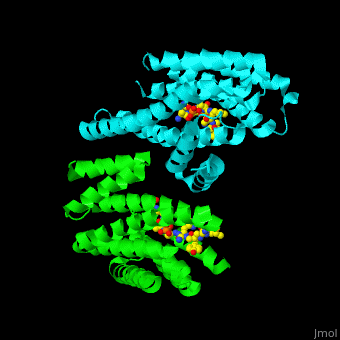14-3-3 protein
From Proteopedia
(Difference between revisions)
| Line 10: | Line 10: | ||
The binding of 14-3-3 proteins to their target proteins can have diverse functional outcomes. It can either activate or inhibit the target protein, modulate its interactions with other proteins, protect it from degradation, or act as a scaffold for protein complex formation. By regulating the activity and localization of their target proteins, 14-3-3 proteins exert tight control over cellular signaling and contribute to the coordination of complex cellular processes. | The binding of 14-3-3 proteins to their target proteins can have diverse functional outcomes. It can either activate or inhibit the target protein, modulate its interactions with other proteins, protect it from degradation, or act as a scaffold for protein complex formation. By regulating the activity and localization of their target proteins, 14-3-3 proteins exert tight control over cellular signaling and contribute to the coordination of complex cellular processes. | ||
| - | + | These proteins are highly context-dependent and vary depending on the specific isoform, cellular location, and interacting partners. They have been implicated in numerous physiological and pathological processes, including neuronal development and function, cell cycle regulation, apoptosis, cancer progression, and neurodegenerative diseases. | |
Research on 14-3-3 proteins continues to uncover their intricate roles in cellular signaling and their involvement in various diseases. Understanding their interactions and regulatory mechanisms provides insights into fundamental cellular processes and offers potential avenues for therapeutic interventions. | Research on 14-3-3 proteins continues to uncover their intricate roles in cellular signaling and their involvement in various diseases. Understanding their interactions and regulatory mechanisms provides insights into fundamental cellular processes and offers potential avenues for therapeutic interventions. | ||
| - | |||
== Disease == | == Disease == | ||
Current revision
| |||||||||||
References
- ↑ Benzinger A, Popowicz GM, Joy JK, Majumdar S, Holak TA, Hermeking H. The crystal structure of the non-liganded 14-3-3sigma protein: insights into determinants of isoform specific ligand binding and dimerization. Cell Res. 2005 Apr;15(4):219-27. PMID:15857576 doi:10.1038/sj.cr.7290290

